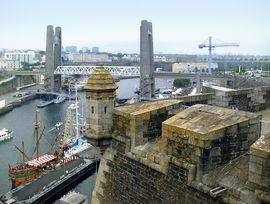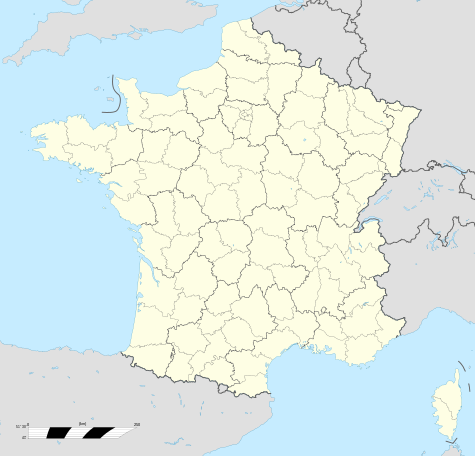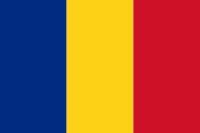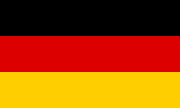Brest, France
|
Brest |
|
 |
|
| View of Brest from the castle | |
 Brest
|
|
|
Location within Brittany region
 Brest
|
|
| Administration | |
|---|---|
| Country | France |
| Region | Brittany |
| Department | Finistère |
| Arrondissement | Brest |
| Intercommunality | Brest Métropole Océane |
| Mayor | François Cuillandre (PS) (2008–2014) |
| Statistics | |
| Elevation | 0–103 m (0–338 ft) (avg. 34 m/112 ft) |
| Land area1 | 49.51 km2 (19.12 sq mi) |
| Population2 | 149,634 (1999) |
| - Density | 3,022 /km2 (7,830 /sq mi) |
| INSEE/Postal code | 29019/ 29200 |
| Website | Official website |
| 1 French Land Register data, which excludes lakes, ponds, glaciers > 1 km² (0.386 sq mi or 247 acres) and river estuaries. | |
| 2 Population sans doubles comptes: residents of multiple communes (e.g., students and military personnel) only counted once. | |
Brest (French pronunciation: [bʁɛst]; Breton: [brest]) is a city in the Finistère department in Brittany in north-western France.
Located in a sheltered position not far from the western tip of the Breton peninsula, Brest is an important seaport and naval base. The 1999 census recorded 303,484 inhabitants of the Brest metropolitan area, while the population of the city itself was estimated in 2004 to number some 146,000. Although Brest is by far the largest city in Finistère, the préfecture (capital) of the department is the much smaller commune of Quimper.
Contents |
Geography
Brest is located amidst dramatic landscape near the entrance of the natural Rade de Brest, at the west end of Brittany.
It is situated to the north of a magnificent landlocked bay, and occupies the slopes of two hills divided by the river Penfeld. The part of the town on the left bank is regarded as Brest proper, while the part on the right is known as Recouvrance. There are also extensive suburbs to the east of the town. The hillsides are in some places so steep that the ascent from the lower to the upper town has to be effected by flights of steps and the second or third storey of one house is often on a level with the ground storey of the next.
History

Nothing definite is known of Brest before about 1240, when a count of Léon ceded it to John I, the Duke of Brittany. In 1342, John de Montfort surrendered Brest to the English, in whose possession it was to remain until 1397. The importance of Brest in medieval times was great enough to give rise to the saying, "He is not the Duke of Brittany who is not the Lord of Brest". With the marriage of Francis I to Claude, the daughter of Anne of Brittany, the definitive overlordship of Brest – together with the rest of the duchy – passed to the French crown.
The advantages of Brest's situation as a seaport town were first recognized by Cardinal Richelieu, who in 1631 constructed a harbor with wooden wharves. This soon became a base for the French Navy. Colbert rebuilt the wharves in masonry and otherwise improved the base. Fortifications by Vauban (1633–1707) followed in 1680-1688. These fortifications, and with them the naval importance of the town, were to continue to develop throughout the 18th century.
In 1694, an English squadron under John Berkeley, 3rd Baron Berkeley of Stratton, was soundly defeated in its attack on Brest.
In World War II, the Germans maintained a large U-boat (submarine) base at Brest. The city was totally destroyed during the Battle for Brest in 1944 after the Allied invasion of Normandy, with barely more than three buildings left standing. After the war, the West German government paid several billion deutschemarks in reparations to the homeless and destitute civilians of Brest in compensation for the destruction of their home city during the course of the war. Large parts of today's rebuilt city consist of utilitarian granite and concrete buildings. The French naval base now houses the Brest Naval Training Centre.
In 1972, the French Navy opened its nuclear weapon-submarine (deterrence) base at Île Longue in the Rade de Brest (Brest roadstead). This continues to be an important base for the French nuclear-armed ballistic missile submarines.
Main sights

Brest is best-known for its Pont de Recouvrance (a massive drawbridge 64 m/210 ft high), the military arsenal and the rue de Siam (Siam Street). The Castle and the Tour Tanguy are the oldest monuments of Brest.
The Musée de la Tour Tanguy houses a collection of dioramas that depict the city of Brest on the eve of World War II. The Musée de la Marine de Brest, housed in the ancient castle, contains exhibits which outline Brest's maritime tradition, as well as an aquarium, the Océanopolis marine centre. The city also has a notable botanical garden specializing in endangered species, the Conservatoire botanique national de Brest, as well as the Jardin botanique de l'Hôpital d'Instruction des Armées Clermont-Tonnerre.
The city of Brest does not have much remaining historical architecture, apart from a few select monuments such as the Castle and the Tour Tanguy. This is due to heavy bombing by the Allies during World War II, in an attempt to destroy the submarine base the Germans had built in the harbour. In the 1950s, the town was hastily rebuilt using a large amount of concrete. In Recouvrance, the west bank of the town, there remains an authentic street of the 17th century, Saint-Malo Street.
A few kilometres out of town, there are more impressive landscapes, from sandy beaches to grottos to tall granite cliffs. Sunbathing, windsurfing, yachting and fishing are enjoyed in the area. Brest was an important warship-producing port during the Napoleonic wars. The naval port, which is in great part excavated in the rock, extends along both banks of the Penfeld.

Coat of arms
.png)
It is in a register of deliberations of the city council dated the 15th July 1683 that this coat of arms was used for the first time.
Transport
The railway station is Gare de Brest and the airport serving the area is Brest Bretagne Airport.
Economy
Due to its location, Brest is regarded as the first French port that can be accessed from the Americas. Shipping is big business, although Nantes and Saint-Nazaire offer much larger docks and attract more of the larger vessels. The protected location of Brest means that its harbor is ideal to receive any type of ship, from the smallest dinghy to the biggest aircraft-carrier (the USS Nimitz has visited a few times).
The Charles De Gaulle aircraft carrier was built by DCN in Brest.
Administration
Mayors of Brest
- since 2001: François Cuillandre
- 1989 - 2001: Pierre Maille (2nd term)
- 1985 - 1989: Georges Kerbrat
- 1983 - 1985: Jacques Berthelot
- 1982 - 1983: Pierre Maille
- 1977 - 1982: Francis Le Blé
- 1973 - 1977: Eugène Berest
- 1959 - 1973: Georges Lombard
- 1958 - 1959: Auguste Kervern
- 1954 - 1958: Yves Jaouen
- 1954 - 1954: Lucien Chaix
- 1953 - 1954: Yves Jaouen
- 1947 - 1953: Alfred Pierre Marie Chupin
- 1945 - 1947: Jules Lullien
- 1944 - 1945: Jules Lullien
- 1942 - 1944: Victor Eusen
- 1929 - 1941: Victor Le Gorgeu
- 1921 - 1929: Léon Nardon
- 1920 - 1921: Hippolyte Masson
- 1919 - 1920: Louis Léon Nardon
- 1912 - 1919: Hippolyte Masson
- 1908 - 1912: Louis Arthur Delobeau
- 1904 - 1908: Victor Marie Aubert
- 1900 - 1904: Charles Berger
Breton language
The municipality launched a linguistic plan to revive Breton as a language through Ya d'ar brezhoneg on 16 June 2006. In 2008 1.94% of the children attended the bilingual schools in primary education.[1]
Breton is not commonly spoken in the city of Brest and is not an official language of France (like other French minority languages). It is being taught in some schools and universities. The association Sked[1] federates all Breton cultural activities.
Brest was the only French-speaking city in western Brittany before the 1789 French Revolution.
Culture
The city is host to several events to celebrate its long maritime history. The largest is held every four years, when the town organises a tall ship meeting. The last such tall ship event was "Brest 2008".
Brest also hosts an annual Short Film Festival called "Festival Européen du Film Court de Brest". The city was the setting for the 1982 art film Querelle, directed by Rainer Werner Fassbinder.
Food
Brittany's most famous local delicacy, the Breton crêpe, is the main culinary feature apart from seafood. There are many crêpe restaurants (called crêperies). Breton apple cideris often featured.
Traditional biscuits include Traou Mad, which is a full-fat butter biscuit, similar to Scottish shortbread.
Sport
Since 1901 Brest has served as the midpoint for the epic 1,200 km (750 mi) bicycle endurance event, Paris–Brest–Paris. Brest is home to Stade Brestois 29, a football team in Ligue 1.
The 2008 Tour de France, a multi-day bicycle race, started in Brest.
Education
- Université de Bretagne Occidentale (UBO) [2]
- Brest has several grandes écoles:
- École nationale d'ingénieurs de Brest (ENIB) [3]
- École nationale supérieure des télécommunications de Bretagne (ENST Bretagne) [4]
- École nationale supérieure des ingénieurs des études et techniques d'armement (ENSIETA) [5]
- Institut supérieur de l'électronique et du numérique de Brest (ISEN Brest) [6]
- École Supérieure de Commerce de Bretagne [7]
- École Navale [8]
- Brest also is one of the hosts for the Indiana University Honors Foreign Language Program
Notable natives
Brest was the birthplace of:
- Jean-Michel Huon de Kermadec (1748–1792), navigator
- Charles-Alexandre Léon Durand Linois (1761–1848), admiral during the time of Napoleon Bonaparte
- Prosper Garnot (1794–1838), surgeon and naturalist
- Victor Segalen (1878–1919), naval doctor, ethnographer, archeologist, writer and poet
- Georges Thierry d'Argenlieu (1889–1964), priest, diplomat and French Navy officer and admiral
- Alain Robbe-Grillet (1922–2008), writer and filmmaker
- Pierre Brice (born 1929), actor
- Béatrice Dalle (born 1964), actress
- Christophe Miossec (born 1964), singer
- Yann Tiersen (born 1970), minimalist multi instrumentalist/musician
- Larsen Touré (born 1984), footballer (naturalized Guinean)
- Gonzalo Higuaín (born 1987), footballer (naturalized Argentine)
Twin towns
 Cádiz, Spain (1986)
Cádiz, Spain (1986) Constanţa, Romania (1993)
Constanţa, Romania (1993)
 Denver, Colorado, United States (1956)
Denver, Colorado, United States (1956) Dún Laoghaire, Ireland (1984)
Dún Laoghaire, Ireland (1984) Kiel, Germany (1964)
Kiel, Germany (1964)
 Plymouth, Devon, United Kingdom (1963)
Plymouth, Devon, United Kingdom (1963) Saponé, Burkina Faso (1989)
Saponé, Burkina Faso (1989) Taranto, Italy (1964)
Taranto, Italy (1964) Yokosuka, Japan (1970)
Yokosuka, Japan (1970)
Friendly relationship
Brest has an official friendly relationship (protocole d'amitié) with:[2]
 Bejaïa, Algeria (1995)
Bejaïa, Algeria (1995)
See also
- Battle for Brest
- Communes of the Finistère department
References
Notes
- ↑ (French) Ofis ar Brezhoneg: Enseignement bilingue
- ↑ 2.0 2.1 Les jumelages de Brest
External links
- Aerial photos of the whole city and urban community
- Brest Airport Travel Guide
- Interactive City Map of Brest
- Official web site of Brest town hall (with webcam)
- Satellite picture by Google Maps
- (French) Cultural Heritage
- Brest improvisation theatre
- Brest Weather Forecast
- "Brest, ma ville, mon âme" Photo gallery : a discovery of the city by Erwan Corre
- Wiki-Brest, a community wiki containing articles about the city (in French).
- German submarine base in Brest
|
|||||